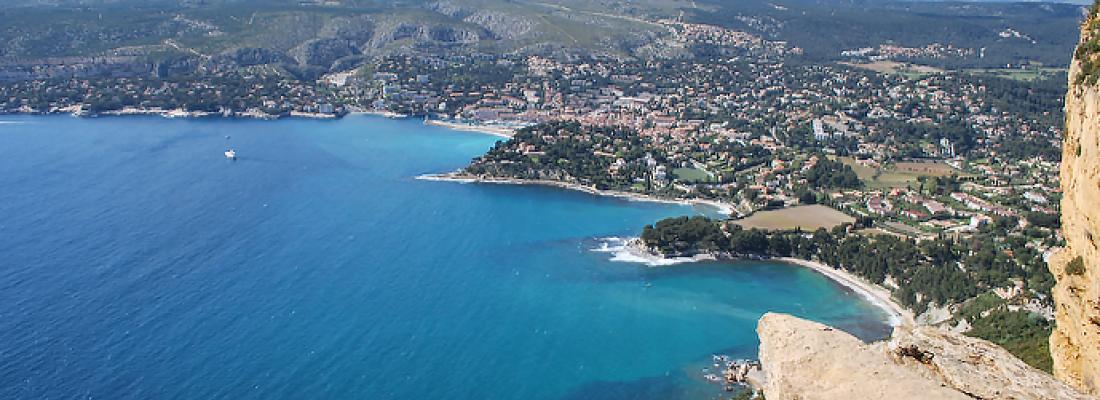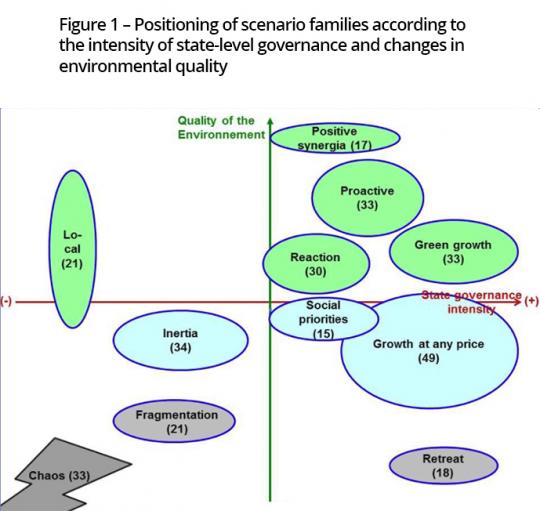Climate change and risks Reading time 4 min
Using environmental scenarios to determine the world’s future
Published on 31 March 2017

For its study, AllEnvi’s cross-disciplinary Foresight team looked at 99 different international foresight studies from the past 15 years outlining 307 environmental scenarios. These studies reflected a western view of future outlooks for the world or large global regions by 2030, 2050 or 2100. Foresight studies, which are most often used to provide insight to public policymakers, can also guide actions. The varied and contrasting scenarios show possibilities for the future and combine perspectives from the environmental and social sciences. They encourage consideration of how our societies can (re)define their future and highlight the importance that various levels of governance have on outcomes.

To analyse these scenarios, researchers grouped them into 11 families based on their views of the future. These families can be categorised into three main groups: families in decline, comprising three scenario families with a pronounced degradation of the environment; three families with economic and social priorities that do not include environmental concerns and which also lead to environmental degradation; and five families with pro-active approaches led by state government or civil society and which prioritise the environment, but for which environmental results remain mixed.
Views with certain blind spots
The IPCC seems to have borne fruit in taking the climate into account.
The driving factors that govern the shifts in these scenarios are governance (40%) and the economy (25%) followed by society. R&D is one of the top two factors in 15% of the scenarios, more for its ability to offer solutions than to signal problems. The initial state of the environment and demographics have little weight among the factors that determine the trajectories. Climate change is nevertheless a root cause in shifts in 50 of the scenarios and a factor of the general state of the environment in 46 of them. Biodiversity, pollution, and soil and water degradation are included in very few of the scenarios, while seas and oceans are never mentioned despite worrisome current knowledge and previously published scientific data. The study develops the hypothesis that the lack of connection between these issues in society makes them invisible in the eyes of decision-makers and stakeholders. However, the IPCC’s role of providing expertise and analysis appears to have made headway in raising awareness of the climate.
The studied corpus excludes regional or local foresight studies that could make it possible to take into account trajectories (excluding the families identified in the study) but where state government influence is weak with environmental improvements being achieved through local actions (empty cell in the figure above).
Cautious views of possible environmental improvement
Of the 307 scenarios studied, less than 30% lead to an improvement in the environment.
Of the 307 scenarios studied, fewer than 30% show environmental improvement and all are from families that prioritise the environment. However, not all of the environmentally-focused scenarios systematically lead to improvements. Some 20% of the studies show both degradation and improvement depending on the area (water, soil, climate, biodiversity, etc.). The remaining 50% describe a trajectory with environmental degradation. Alongside this rather discouraging view, the possible trajectories – even the most environmentally optimistic – show an increased risk of natural disasters such as flooding, heat waves and storms. The trajectories also frequently describe a rise in environmental risks, regardless of the type of risk considered.
This bleak outlook reflects the restraint on the part of the foresight study authors to not be overly optimistic and to take into account certain environmental damage that will be difficult to reverse. For water and soil, the scenarios most often envision degradation rather than improvement. Few scenarios take into account consequences on forests, oceans or coastlines, but those that do generally lean towards degradation.
Consolidating the views for research programmes
This study, which draws from a total of 99 foresight studies and 307 scenarios, makes it possible to overcome some of the inherent biases of foresight studies, including the choice of data sources, the composition of expert groups, etc. It also offers a precise overview of the data used and any neglected fields. With regard to biodiversity, initiatives rolled out by the Intergovernmental Science-Policy Platform on Biodiversity and Ecosystems (IPBES) based on the IPCC climate model should help improve consideration of these data. For forests, coastlines and oceans, there is an urgent need to develop structured initiatives.
This overview helps create a long-term vision to guide scientific research programmes. It will be a useful resource to help research organisations and regions set their priorities.
The ScenEnvi study
The ScenEnvi study was conducted by the French national alliance for environmental research, which plans and coordinates French environmental research to tackle major societal challenges related to food, water, climate and regions. INRA is one of the alliance’s 12 founding organisations and works with 16 other associated members.
INRA's Delegation for Collective Scientific Expertise, Foresight and Advanced Studies was a key player in leading, coordinating and conducting this study. After determining the corpus, the various scenarios were described based on reading notes and grouped according to their two main drivers: governance, demographics, economy, social environment or technology (and science).
The impact for inra
“For me, the interest lies in placing our agricultural, agro-environmental and food priorities within a more comprehensive future context than simply extending trends. We also need to base our assessments on various possible trajectories for our societies (take, for example, the positioning of global food security research). We need to make sure we are considering all the essential issues highlighted by the foresight studies and that the research outcomes and resulting knowledge and innovations can lead to smart decisions that can suit various trajectories.”
